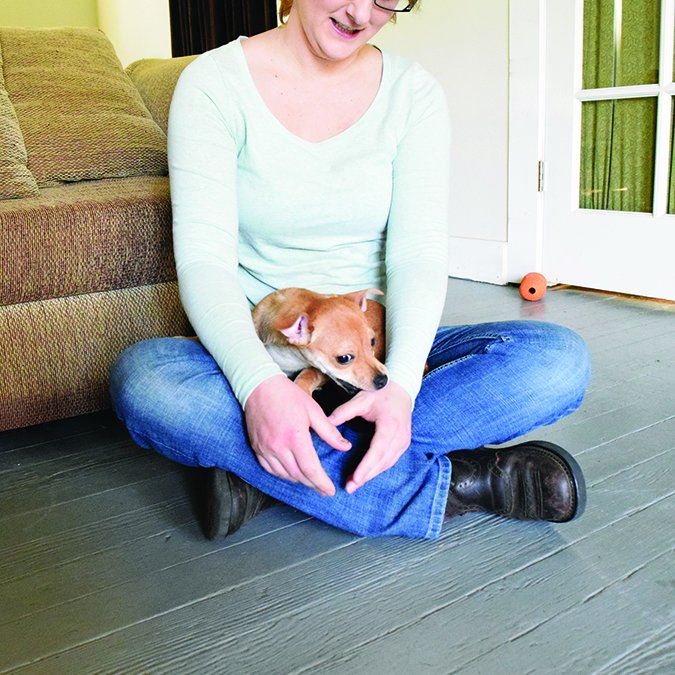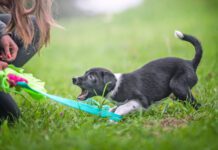Some puppies have a naturally soft bite; some joyfully shred flesh without a hint of malice as they engage in normal interactions with the humans who care for them. Teaching your puppy bite inhibition when they’re young will save you a lot of trouble during their later years.
It’s a commonly accepted theory that puppies who control the strength of their bite in play (known as bite inhibition) are more likely to also inhibit their bite on occasions that may arise throughout their lives if/when they feel compelled to bite for real – not just in play. Adult dogs who have good bite inhibition, the theory suggests, will thus inflict far less damage if a bite does occur.
So, what determines how hard a puppy will bite? And, more importantly, is there anything you can do to help him develop a harmlessly “soft” bite?
Reasons Some Dogs Bite Hard
There are a number of things that may contribute to the propensity of a dog to bite down hard when he bites:
– Genetics. As with most behaviors, there’s a good chance that the amount of pressure a dog applies when he bites is at least partly due to a genetic propensity for hard or soft biting. (But don’t despair over what hard-mouthed genes your dog may have inherited; it’s also true that, as with most behaviors, the natural strength of a puppy’s bite can be modified, at least to some degree. And the more chances a pup has to practice soft biting, the easier it becomes to modify it.)
– Early experience. In the first few weeks of life, a puppy learns how and why to control the pressure of his teeth. If he bites too hard while nursing, Mom might just get up and walk away, taking the milk bar with her. In behavioral terms, we’d call this negative punishment – his behavior made the good stuff go away. If he bites too hard while playing, his siblings are likely to quit playing with him. Many canine behavior professionals agree that orphaned puppies and those who are removed from their litters too early (prior to the age of eight weeks) are far more likely to have poor bite inhibition than those who learn mannerly mouth behavior through normal puppy social experiences.
– Stress and/or Excitement. Stress and excitement create tension, and that tension can often be felt in the mouth. Even a calm dog with a soft bite may increase the pressure of his bite when he is stressed (you can feel it when you feed him a treat). For a dog who already has a hard bite, the pain of feeding him a treat when he’s stressed can be nearly unbearable.
The Four Rs of Teaching Puppy Bite Inhibition
Here are the four most effective steps for building your puppy’s bite inhibition:
1. Remove. When your puppy bites hard enough to cause you pain, say, “Ouch” in a calm voice, gently remove your body part from his mouth, and take your attention away from him for two to five seconds. You’re using negative punishment, just like his mom and littermates. If he continues to grab at you when you remove your attention, put yourself on the other side of a baby gate or exercise pen. Re-engage only when he’s calm.
2. Repeat. Puppies (and adult dogs) learn through repetition. It will take time – and many repetitions of Step 1, “Remove” – for your pup to learn to voluntarily control his bite pressure. Puppies have a strong need to bite and chew, so at first, “ouch and remove” only if he bites hard enough to hurt you. Softer bites are acceptable for now. If you try to stop all his biting at once, you’ll both become frustrated. Look for just a small decrease in his bite pressure at first.
When he voluntarily inhibits his bite a little – enough so that it doesn’t hurt – you can then start responding with “ouch and remove” for slightly softer bites, until you have eventually shaped him not to bite at all. By the time he’s six to eight months old, he should have learned not to put his mouth on humans, unless you choose to teach him to mouth gently on cue.
3. Reinforce. Like all dogs (and humans), your pup wants good stuff to stick around. When he discovers that biting hard makes you (good stuff) go away, he will decrease the pressure of his bite, and eventually stop biting hard.
This works especially well if you remember to reinforce him with your attention when he bites gently. It works even better if you use a reward marker when he uses appropriate mouth pressure. Given that your hands are probably full of puppy at that particular moment, you might choose use a verbal marker followed by praise to let him know he’s doing well. “Yes!” marks the soft-mouth moment, followed by calm “Good puppy!” praise to let him know he’s wonderful. (If you praise too enthusiastically you may get him excited and cause him to increase his bite pressure again.)
4. Redirect. It’s always a good idea to have soft toys handy to occupy your pup’s teeth when he’s in a persistent biting mood. If you know he’s in high-energy, hard-bite mode, arm yourself with a few soft toys and offer them before your hands are punctured. If he’s already made contact, or you’re working on repetitions of “Remove,” reinforce appropriate softer bites occasionally with a favorite toy.
If there are children in the home with a mouthy puppy, it’s imperative that you arm them with soft toys and have toys easily available in every room of the house, so they can protect themselves by redirecting puppy teeth rather than running away and screaming – a game that most bitey pups find highly reinforcing.
Never Do These Things When Teaching a Puppy Bite Inhibition
Over the years, I’ve cringed at a variety of tactics that I’ve seen or heard people suggesting for modifying puppy-mouthing. Here are some of the worst – things you don’t want to do:
1. Alpha-rolls. You are likely to elicit a whole lot more biting – truly aggressive biting – as your frightened pup tries to defend himself. Don’t do it. (See “Puppies Who Demonstrate ‘Alpha’ Behavior,” WDJ July 2006.)
2. Hold his mouth closed, push your fist down his throat, push his lip between his teeth so he bites himself, or bite him back. All of these are bad ideas. What self-respecting puppy wouldn’t struggle and try to bite harder with inappropriate restraint? All the while, you’re giving your pup a bad association with your hands near his face, which isn’t going to help with grooming, tooth-brushing, mouth exams, or even petting. Don’t do it.
3. Give a high-pitched yelp. This one might surprise you. It’s in a different category from the inappropriate suggestions above, and it’s often suggested by positive trainers. The theory is that the high-pitched yelp sounds like a puppy in pain, communicating to your young dog in a language he understands. But it’s a fallacy to think our feeble attempt to speak “puppy” might communicate the same message as a real puppy yelp – like trying to speak a foreign language by mimicking what we think the sounds are, without actually knowing any of the words. In my experience, the yelp is as likely to incite an excited biting puppy to a higher level of arousal (and harder biting) as it is to tell him he bit you too hard and he should soften his mouth. Don’t do it. A calm “Ouch” sends a much more consistent, useful and universal message, which is simply, “That behavior makes the good stuff go away.”
Why We Don’t Punish Dogs for Hard Mouthing
It may seem simpler, quicker and easier to suppress a puppy’s hard biting by punishing him when he bites too hard. However, by doing so, you may teach him to fear you, and he may aggress back at you, creating a bigger behavior problem – and you haven’t taught him bite inhibition. If and when that moment comes where he really does feel compelled to bite someone, he’s likely to revert to his previous behavior and bite hard, rather than offering the inhibited bite you could have taught him. Helping him learn to modulate his bite, instead, will pay lifelong dividends.
Author Pat Miller, CBCC-KA, CPDT-KA, is WDJ’s Training Editor.






This was an agreeable read up until the point where it is said that “it’s a fallacy to think our feeble attempt to speak “puppy” might communicate the same message as a real puppy yelp – like trying to speak a foreign language by mimicking what we think the sounds are, without actually knowing any of the words”. When you learn a foreign language the whole process is based on finding out what a particular word communicates and the ‘mimicking’ the pronunciation to the best of your ability. The same thing would apply when giving a yelp; we know what a yelp communicates and the animal knows what a yelp communicates, we also both understand the nuances in how a yelp may sound – thus, being that we do know the ‘word’ or more appropriately the sound and meaning; we can produce an effective yelp having the puppy release our body part and then turning our attention away from them until they are calm. Animals do indeed react to humans producing the sounds that they use for communication. If they did not – hunters would not be able to successfully use tactics like elk calls or duck calls to get animals to come closer in thinking it is a female or another wounded animal, and ornithologists would not successfully utilize pishing (verbal bird scolds and alarm calls). I sat in a car once with a couple dogs as we waited for their owner to return; and as they eagerly peered out the window for their owner I decided to start whimpering to see what their response would be. They both whipped their heads around and started trying to comfort me by licking and nudging me. Sounds can be ‘mimicked’ and get a message across, especially if paired with real emotion. Auditory and visual imitation or ‘mimicking’ has been documented across several species on earth.
I just got a 3.5 months old labradoodle puppy. She bites hard. I tried the yelping, initially she did stop for a couple times, then it made her go more crazy. I probably sounded like a squeaky toy and it was fun to her. Now I’m trying with an ouch (takes some control on my part to say it in a calm tone cos it’s really painful!) and firm no, it seems to help a little. Fingers crossed. Guess every puppy is different, just have to find what works.
Always sharing us great articles! MAny thanks!
When I got my GSD pup, her breeder cheerfully warned me, “they are like little crocodiles, so get the bite inhibition training going right away!” Very true – my forearms would sport some ‘war wounds’ and I learned one good lesson. When those puppy teeth come in contact with the skin, don’t pull away quickly. It was never a proper chomp, more like whipping the mouth around with the teeth on display and unfortunately catch the skin. The teeth would superficially tear my skin, not deep cuts, but the top layer would peel back. Man, was it painful! I went through a few bandages, Polysporin ointment, etc.
Finally I waged a serious, repetitious war with one word — “EH!!!” It worked.
This is a great article, thanks for this.
Have a new Scottish Terrier Pup. She has very sharp teeth and uses them on anything and everything. ,including a metal coffee table tried yelping, spraying with water bottle asking her softly no bite, non working.,